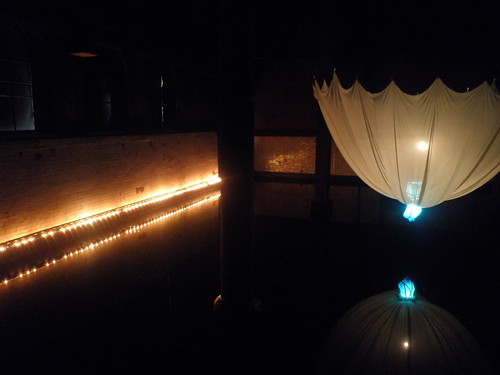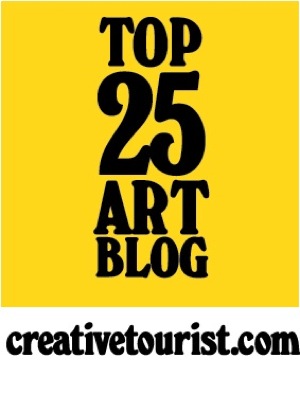Last weekend I visited The Wapping Project for the first time. Built in 1890, this extraordinary and beautiful building was originally the Wapping Hydraulic Power Station, but is now a restaurant and contemporary art space. Some of the machinery from the original power station is still in situ in the very tempting-looking restaurant, which unfortunately I didn't get chance to sample on this occasion, though I'm looking forward to going back to try it another time. As well as the restaurant, the venue houses the Boiler House - an exhibition/installation space - and an art bookshop housed in a greenhouse,as well as outdoor artworks.
The installation currently in the Boiler House is no less extraordinary than the building itself. Yohji Making Waves is a single-piece, site-specific installation created by fashion designer and artist Yohji Yamamoto, in collaboration with scenographer Masao Nihei. In this work, the cavernous, darkened Boiler House space is flooded with water, and a beautiful, oversized silk wedding dress (an iconic piece taken from the designer's autumn/winter 1998 collection) is suspended above it, reappearing as a ghostly reflection in the dark, rippling waters. The space is lit by a string of bulbs sending glimmering light out across the water, a haunting soundtrack plays, and visitors can take a closer look at the dress by clambering aboard a small boat, which a boatman rows around the flooded gallery at regular intervals.
There's something both mesmeric and meditative about this atmospheric installation. But although there's an eerily beautiful quality to the black depths of the water, and spectral floating dress, there's also something hugely fun and anarchic about the very idea of flooding a gallery and rowing around it in a boat. In this way, as well as being contemplative, this is an enchantingly playful installation: it's little wonder that our fellow gallery visitors were beaming with delight as they hopped aboard the little boat and set off across the water.
The installation is the third element of a series of exhibitions devoted to Yamamoto's work in London this summer: the others, which I haven't had chance to visit as yet, are Yohji's Women, an exhibition of photographs at The Wapping Project Bankside, and of course Yohji Yamamoto, a major solo exhibition at the V&A. However, whether or not you're a fan of Yamamoto, I'd highly recommend visiting this installation: one of the most imaginative and appealing pieces of contemporary art I've seen for some time.
It's surprisingly difficult to find details of the installation online, but it is open daily - Monday - Friday from 12 noon - 10pm and Saturday-Sunday from 10am. Boat rides take place every 15 minutes. The installation is free to enter but a ticket is required for the boat.
Yohji Making Waves is at the Wapping Project until 10 July 2011.
Yohji Making Waves is at the Wapping Project until 10 July 2011.
[Image by Madeline Graham via Flickr used under Creative Commons]



















